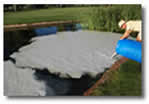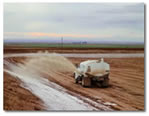Installation
Waterborne Method
A Waterborne application of ESS-13 is highly effective in minimizing the amount of water loss due to seepage in ponds or lakes. Even lakes that were previously lined with PVC, native clay or bentonite can be successfully treated with this method.
A Waterborne application of ESS-13 usually requires one gallon of ESS-13 to every 2,000 gallons of water, although this rate may vary. The product is either poured or pumped into the water at various locations. Over the next few hours, the product will disperse throughout the entire body of water, covering every square inch of soil surface.
The majority of the sealing action takes place in the first 72 hours. Typical results vary from a 60% to 90% reduction in the amount of water loss due to seepage, and this initial reduction will continue to improve with time.
Test data shows that ESS-13 is non-toxic to aquatic life and any effect would be only at concentrations significantly higher than our standard treatment. An aquatic toxicity report is available upon request.
For more information, or to tell us about your project, please contact your Seepage Control representative today!
 A waterborne application of ESS-13 to existing bodies of water usually requires one gallon of ESS-13 to each 2,000 gallons of water, although application rates may vary. Prior to the application, a staff gauge or yardstick should be driven into the lake and the loss in vertical inches measured for 24 hours. This should be done at the full water level.
A waterborne application of ESS-13 to existing bodies of water usually requires one gallon of ESS-13 to each 2,000 gallons of water, although application rates may vary. Prior to the application, a staff gauge or yardstick should be driven into the lake and the loss in vertical inches measured for 24 hours. This should be done at the full water level. Pump or pour the ESS-13 into the water at various locations and it will mix and distribute by itself. This usually takes from six to ten hours. Utilizing aeration or other forms of turbulent mixing is a great way to speed up the dispersion process. A 2” self-priming trash/water pump is ideal for pumping ESS-13 into the lake.
Pump or pour the ESS-13 into the water at various locations and it will mix and distribute by itself. This usually takes from six to ten hours. Utilizing aeration or other forms of turbulent mixing is a great way to speed up the dispersion process. A 2” self-priming trash/water pump is ideal for pumping ESS-13 into the lake. The majority of the sealing action takes place in the first 72 hours. After this 72 hour period the water will remain hazy white for several days to several weeks. In most cases the water can be used for irrigation before the water clears, however please contact your Seepage Control representative prior to irrigating. Seventy two hours after the treatment take another 24-hour loss measurement. The comparison will give you an initial seepage rate reduction (typically 80-90%, negiecting projects involving mechanical failure (ie. pipe penetrations, sink holes, etc.)).
The majority of the sealing action takes place in the first 72 hours. After this 72 hour period the water will remain hazy white for several days to several weeks. In most cases the water can be used for irrigation before the water clears, however please contact your Seepage Control representative prior to irrigating. Seventy two hours after the treatment take another 24-hour loss measurement. The comparison will give you an initial seepage rate reduction (typically 80-90%, negiecting projects involving mechanical failure (ie. pipe penetrations, sink holes, etc.)). Whatever the initial reduction is, remember that the product continues to reduce the seepage rate of the pond with time.
Whatever the initial reduction is, remember that the product continues to reduce the seepage rate of the pond with time.








